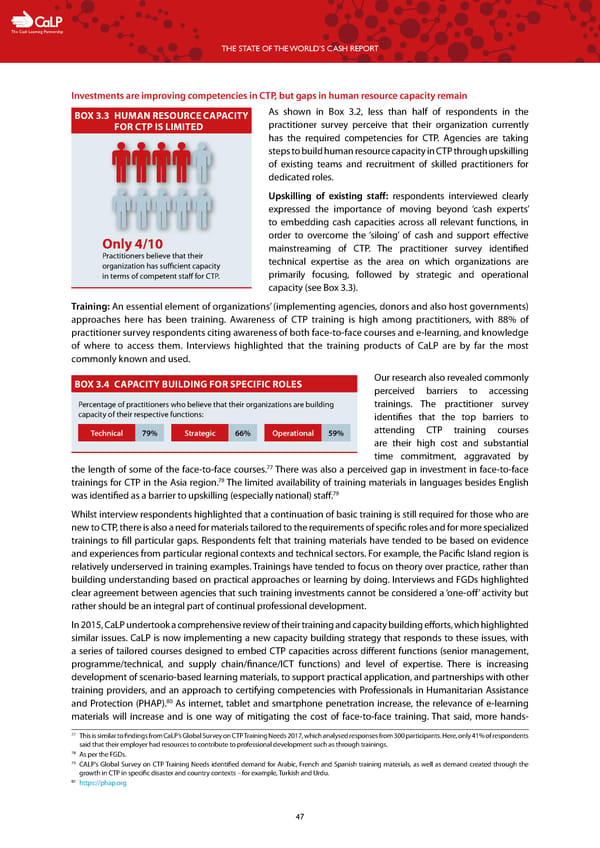C The Cash Learning Partnership THE STATE OF THE WORLD’S CASH REPORT Investments are improving competencies in CTP, but gaps in human resource capacity remain BOX 3.3 HUMAN RESOURCE CAPACITY As shown in Box 3.2, less than half of respondents in the FOR CTP IS LIMITED practitioner survey perceive that their organization currently has the required competencies for CTP. Agencies are taking steps to build human resource capacity in CTP through upskilling of existing teams and recruitment of skilled practitioners for dedicated roles. Upskilling of existing staff: respondents interviewed clearly expressed the importance of moving beyond ‘cash experts’ to embedding cash capacities across all relevant functions, in Only 4/10 order to overcome the ‘siloing’ of cash and support effective Practitioners believe that their mainstreaming of CTP. The practitioner survey identified organization has sufficient capacity technical expertise as the area on which organizations are in terms of competent staff for CTP. primarily focusing, followed by strategic and operational capacity (see Box 3.3). Training: An essential element of organizations’ (implementing agencies, donors and also host governments) approaches here has been training. Awareness of CTP training is high among practitioners, with 88% of practitioner survey respondents citing awareness of both face-to-face courses and e-learning, and knowledge of where to access them. Interviews highlighted that the training products of CaLP are by far the most commonly known and used. BOX 3.4 CAPACITY BUILDING FOR SPECIFIC ROLES Our research also revealed commonly perceived barriers to accessing Percentage of practitioners who believe that their organizations are building trainings. The practitioner survey capacity of their respective functions: identifies that the top barriers to Technical 79% Strategic 66% Operational 59% attending CTP training courses are their high cost and substantial time commitment, aggravated by 77 the length of some of the face-to-face courses. There was also a perceived gap in investment in face-to-face 78 trainings for CTP in the Asia region. The limited availability of training materials in languages besides English 79 was identified as a barrier to upskilling (especially national) staff. Whilst interview respondents highlighted that a continuation of basic training is still required for those who are new to CTP, there is also a need for materials tailored to the requirements of specific roles and for more specialized trainings to fill particular gaps. Respondents felt that training materials have tended to be based on evidence and experiences from particular regional contexts and technical sectors. For example, the Pacific Island region is relatively underserved in training examples. Trainings have tended to focus on theory over practice, rather than building understanding based on practical approaches or learning by doing. Interviews and FGDs highlighted clear agreement between agencies that such training investments cannot be considered a ‘one-off’ activity but rather should be an integral part of continual professional development. In 2015, CaLP undertook a comprehensive review of their training and capacity building efforts, which highlighted similar issues. CaLP is now implementing a new capacity building strategy that responds to these issues, with a series of tailored courses designed to embed CTP capacities across different functions (senior management, programme/technical, and supply chain/finance/ICT functions) and level of expertise. There is increasing development of scenario-based learning materials, to support practical application, and partnerships with other training providers, and an approach to certifying competencies with Professionals in Humanitarian Assistance 80 and Protection (PHAP). As internet, tablet and smartphone penetration increase, the relevance of e-learning materials will increase and is one way of mitigating the cost of face-to-face training. That said, more hands- 77 This is similar to findings from CaLP’s Global Survey on CTP Training Needs 2017, which analysed responses from 300 participants. Here, only 41% of respondents said that their employer had resources to contribute to professional development such as through trainings. 78 As per the FGDs. 79 CALP’s Global Survey on CTP Training Needs identified demand for Arabic, French and Spanish training materials, as well as demand created through the growth in CTP in specific disaster and country contexts – for example, Turkish and Urdu. 80 https://phap.org 47
 The State of the World's Cash | Full Report Page 48 Page 50
The State of the World's Cash | Full Report Page 48 Page 50